Furstenberg’s proof of long arithmetic progressions Introduction to Roth’s Theorem
【初中化学】哈伯的学术成就

【初中化学】哈伯的学术成就电化学还原获得编外讲师职位后,哈伯开始从事电化学研究。
他的第一项成果,是硝基苯的还原作用。
这项研究,使他声名鹊起。
这时的哈伯,最擅长的仍是有机化学,但同时,他又将新学到的物理化学知识应用于有机化学中。
盖特曼(l.gattermann)及其他的化学家,对硝基化合物的电化学还原反应进行过研究,获得大量的不同还原态产物。
当时的研究似乎表明,这些还原产物的性质和相对比例,取决于电解质的酸碱度、电流密度、通电时间和金属电极的性质。
认为还原作用是由初生态氢引起的。
但这种观点,无法解释初生态氢在活性上的巨大差异。
1898年,哈伯确立了电极电势的重要性,澄清了电化学中的一些错误认识。
按照能够斯特(h.w.nernst)理论,气体的电极电势由电极上气体的有效率浓度同意。
哈伯认识到,电极电势由阴阳两极气体活度的比值所同意。
在1898年刊登的关于硝基苯的电化学还原成反应的论文中,哈伯首次明确提出电极电势同意还原成能力的观点,指出电极电势越高,还原剂的还原成能力越弱。
早期的研究者通常用比较恒定的电流密度,逐渐减小阴极的电势。
哈伯指出,这样相等于采用还原性逐渐进一步增强的一系列化学还原剂,同时分解成一系列主要还原成产物。
哈伯计划在电解过程中发生改变电流,在电流密度-电极电势曲线的转折点下,维持被极化阴极的电势恒定,这样,放出的氢用以还原成回去极剂。
为了从高的阴极电势已经开始,逐步拆分主要的还原成产物,哈伯用氢逊于电势高的铂(有时用镍)并作电极。
他指出,氢逊于电势低的电极例如锌,可以产生很强的还原成反应。
他接纳勒金的建议,采用辅助电极测量和掌控阴极的电势,用薄壁毛细玻璃管将辅助电极和阴极相连,这样就消解了通过电解液的电势再降。
他用铂作阴极,在低电势下电解硝基苯的碱溶液,出乎原先的预料,得到主要产物是氧化偶氮苯。
根据巴姆贝格(barmberger)一系列有关硝基苯、亚硝基苯和苯胲还原的研究,哈伯证明电化学还原反应和普通的化学还原反应遵循同样的步骤:rno2(硝基苯)→rno(亚硝基苯)→rnhoh(苯胲)→rnh2(苯胺),其它产物来源于副反应。
科学家找到“吝啬基因”

l
界
、 ‘ - 、iI}1 H } 1
突 起 部 位 受 损 的病 人 能够 牢 牢 地 还 未搞清 楚 , 以当有“ 所 一扇 门” 打 罗福特 斯 给这 种现 象起 了一 名字 : 回忆起 事发 前的 小事 , 而对 事 发后 不 开 、 密码 ” 锁 住 时 , 忆 就 会 想象膨胀 , “ 被 记 又称虚假记忆 。 的任何 事情都 没有 记忆 , 有 的却 还
与之相反 。 2 世纪 7 O O年 代 ,美 国报 道 了
一
出现空 白。除 了各种 自然 、 理性 、 病
罗福特斯对研 究虚假记忆 的 目
创伤 性记 忆衰 退外 , 有一 种 虚幻 的 , 还 就是 想制 止一 些心 理 医生诱 导 记忆 。几乎人人 都有记错 事情 的时 病人 的想 象 , 从而 制造 冤假 错案 的
个典 型病例 : 位癫 痫 患者 由于 候 。如 明明记得 刚才把书放在 桌子 做法 。 一 当然 ,虚假记 忆也不是完全 没
癫 痫 频 繁 发作 而 切 除 了脑 双 侧 部 上 了 , 就是 找不 到 。经过翻 箱 倒 可
才 比 分颞 叶和海 马 。手术后 , 该病 患 的 柜之 后 , 突然发 现要 找 的书竟 然 用 。它可 以帮助 治 疗某 些疾 病 , 癫 痫 发 作 频 率 下 降 ,智 力略 有 恢 在沙 发上。难 道把书放在 桌子上 的 如对厌食 症的治疗 。厌食症 患者 自 复 ,但 明显地 发生 了记忆 障碍 , 即 动 作 根本 没 有发 生 ,只 是 一 种 幻
天 的情 形。这 种奇怪 的“ 记忆 ” 从 忆之 谜 的道路 依 旧漫长 而艰 巨, 但
前景仍然 是光 明和 乐观 的 。
大 脑皮 层上 的, 由于编 码 的 原因 心理 学 的角度看 是 根本 不可 能 的 。 但
[教学]全新版大学英语综合教程2(第二版)UNIT3课后语句翻译
![[教学]全新版大学英语综合教程2(第二版)UNIT3课后语句翻译](https://img.taocdn.com/s3/m/f0696e1dba68a98271fe910ef12d2af90242a8fc.png)
Text AProfessor Hawking thinks it important to keep everybody in touch withwhat science is about. In this article he explains why.霍金教授认为使每个人都了解科学是干什么的非常重要。
在这篇文章中,他对其中的缘由作了解释。
Public Attitudes Toward ScienceStephen Hawking1 Whether we like it or not, the world we live in has changed a g reatdeal in the last hundred years, and it is likely to ch ang e ev en more inthe next hundred. Some people would like to stop these changes and go backto what they see as a purer and simpler ag e. Bu t as history sh ows, th epast was not that wonderful. It was not so bad for a privileged min ority,though even they had to do without modern medicine, and childbirth washighly risky for women. But for the vast majority of th e population, lifewas nasty, brutish, and short.公众科学观斯蒂芬·霍金无论我们是否愿意,我们生活的世界在过去一百年间已经变化了许多,而且在未来的一百年里可能变化更多。
犯罪心理长洱英文诗
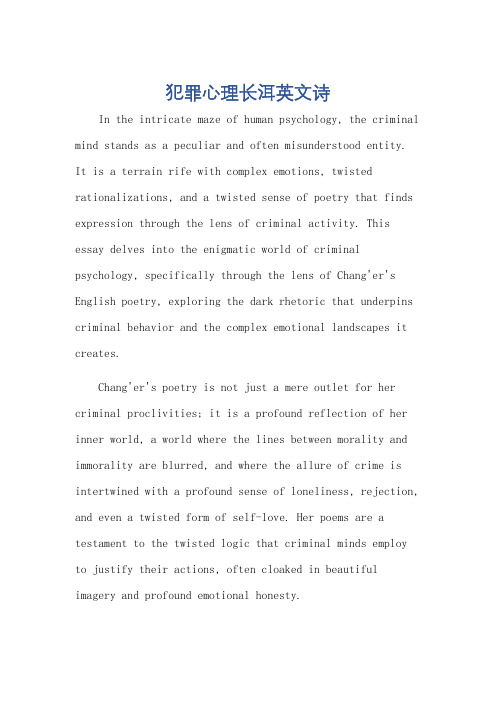
犯罪心理长洱英文诗In the intricate maze of human psychology, the criminal mind stands as a peculiar and often misunderstood entity.It is a terrain rife with complex emotions, twisted rationalizations, and a twisted sense of poetry that finds expression through the lens of criminal activity. This essay delves into the enigmatic world of criminal psychology, specifically through the lens of Chang'er's English poetry, exploring the dark rhetoric that underpins criminal behavior and the complex emotional landscapes it creates.Chang'er's poetry is not just a mere outlet for her criminal proclivities; it is a profound reflection of her inner world, a world where the lines between morality and immorality are blurred, and where the allure of crime is intertwined with a profound sense of loneliness, rejection, and even a twisted form of self-love. Her poems are a testament to the twisted logic that criminal minds employ to justify their actions, often cloaked in beautiful imagery and profound emotional honesty.One of the most striking aspects of Chang'er's poetryis her ability to turn criminal behavior into an almost artistic endeavor. She elevates the mundane and even repulsive aspects of crime to a level of aesthetic appreciation, much like a painter might capture the beautyin a decaying rose. This aestheticization of crime is not just a tactic to distance herself from the harsh realitiesof her actions; it is a way for her to find meaning and purpose in a world that often feels cold and uncaring.However, this aestheticization is not without its costs. Beneath the veneer of beauty and poetry, there lies a deep-seated emptiness and lack of empathy that is the hallmarkof criminal psychology. Chang'er's poems, while beautifulin their own right, often lack a true connection with the emotions and experiences of others. Her world is one of selfish indulgence and narcissistic gratification, wherethe needs and desires of others are often sacrificed to further her own agenda.The criminal mind, as reflected in Chang'er's poetry,is a complex and multifaceted entity. It is a landscape where beauty and ugliness coexist, where the lines betweenright and wrong are blurred, and where the pursuit of personal gain often comes at the cost of others' pain and suffering. Understanding this criminal psychology iscrucial in our efforts to combat crime and promote a more just and equitable society.Chang'er's poetry, while beautiful and profound, serves as a cautionary tale of the dangers of criminal psychology. It reminds us that behind every criminal act lies a complex emotional landscape that is often shaped by a lack of empathy, a twisted sense of morality, and a profound sense of isolation. It is this understanding that can help us better navigate the treacherous terrain of criminal behavior and create a safer, more compassionate world.**犯罪心理深处的诗歌:深入剖析长洱的诗歌**在人类心理学的错综复杂中,犯罪心理作为一个独特且常被误解的领域,充满了复杂的情感、扭曲的理性化和一种通过犯罪活动体现的扭曲的诗歌感。
哲味谚语

哲味谚语●The belief in a supernatural source of evil is not necessary.Men alone are quite capable of every wickedness.——Joseph Conrad【约瑟夫•康拉德(波兰出生的英国作家):将邪恶的产生归结于超自然的因素是没有必要的,人类自身就足以实施每一种恶行。
】●Try again.Fail again.Fail better.——Samuel Beckett【Samuel Beckett(当代最著名的荒诞剧作家):再试,再失败,更好地失败。
】●Try not.Do or do not.——Yoda【尤达大师(『星球大战』中的主角):别试。
做或者不做。
】●All is riddle,and the key to a riddle...is another riddle.——Emerson【爱默生(美国诗人、散文家、哲学家):所有的事物都是谜团,而解开一个谜的钥匙……是另一个谜。
】●The farther backward you can look,the farther forward you will see.——Winston Churchill【温斯顿•邱吉尔:你回首看得越远,你向前也会看得越远。
】●When you look long into an abyss,the abyss looks into you.——Nietzsc he【尼采:当你凝视深渊时,深渊也在凝视你。
】●There are certain clues at a crime scene which,by their very natu re, d o not lend themselves to being collected or examined.How does one collect love, rage, hatred, fear?——Dr. James T. Reese【詹姆斯•瑞斯博士(美国精神创伤压力处理方面的专家):犯罪现场中的某些线索根据它们自己本身的性质,是不容易收集起来检测的。
新教伦理与资本主义精神新版英文译者前言

The Protestant ethic and the spirit of capitalism/Max Weber; “Prefatory remarks” to
Collected essays in the sociology of religion [“Vorbemerkung,” Gesammelte Aufsätze
Publisher and Editor: Claude Teweles Production Editor: Jim Ballinger Copyeditor: Susan Converse-Winslow Proofreaders: Renée M. Burkhammer and Dawn VanDercreek Assistant Editors: Casey Haymes, Josh Levine, Raoul Limeres, Heather Setrakian, and Kate Shaffar Tography: Synergistic Data Systems Cover Design: Marnie Kenney
The Task of the Investigation . . . . . . . . . . . . . . . . . . . 47
Part II: The Vocational Ethic of Ascetic Protestantism
Chapter IV.
The Religious Foundations of This-Worldly Asceticism . . . . . . . . . . 53 A. Calvinism . . . . . . . . . . . . . . . . . . . . . . . . . 55 B. Pietism . . . . . . . . . . . . . . . . . . . . . . . . . . 80 C. Methodism . . . . . . . . . . . . . . . . . . . . . . . . . 89 D. The Baptizing Sects and Churches. . . . . . . . . . . . . . . . 93
Why Your DNA Isn't Your Destiny DNA不是一切 (英语原文+中文译文))
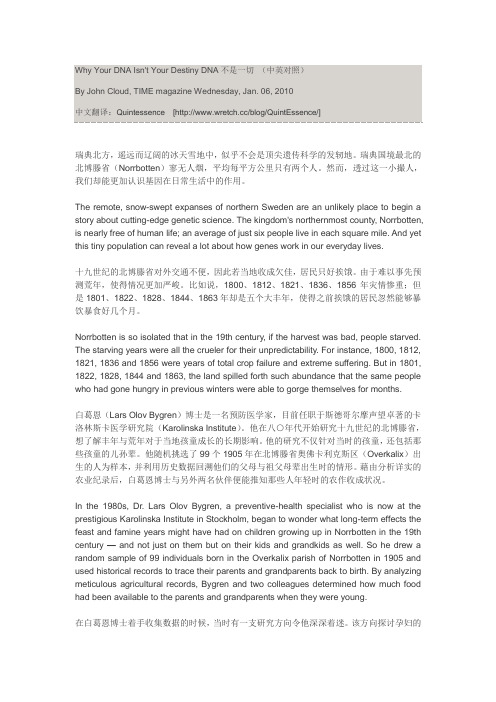
Why Your DNA Isn't Your Destiny DNA不是一切(中英对照)By John Cloud, TIME magazine Wednesday, Jan. 06, 2010中文翻译:Quintessence [/blog/QuintEssence/]瑞典北方,遥远而辽阔的冰天雪地中,似乎不会是顶尖遗传科学的发轫地。
瑞典国境最北的北博滕省(Norrbotten)寥无人烟,平均每平方公里只有两个人。
然而,透过这一小撮人,我们却能更加认识基因在日常生活中的作用。
The remote, snow-swept expanses of northern Sweden are an unlikely place to begin a story about cutting-edge genetic science. The kingdom's northernmost county, Norrbotten, is nearly free of human life; an average of just six people live in each square mile. And yet this tiny population can reveal a lot about how genes work in our everyday lives.十九世纪的北博滕省对外交通不便,因此若当地收成欠佳,居民只好挨饿。
由于难以事先预测荒年,使得情况更加严峻。
比如说,1800、1812、1821、1836、1856年灾情惨重;但是1801、1822、1828、1844、1863年却是五个大丰年,使得之前挨饿的居民忽然能够暴饮暴食好几个月。
Norrbotten is so isolated that in the 19th century, if the harvest was bad, people starved. The starving years were all the crueler for their unpredictability. For instance, 1800, 1812, 1821, 1836 and 1856 were years of total crop failure and extreme suffering. But in 1801, 1822, 1828, 1844 and 1863, the land spilled forth such abundance that the same people who had gone hungry in previous winters were able to gorge themselves for months.白葛恩(Lars Olov Bygren)博士是一名预防医学家,目前任职于斯德哥尔摩声望卓著的卡洛林斯卡医学研究院(Karolinska Institute)。
汉斯费歇尔德国生物化学家1930年诺贝尔化学奖得主
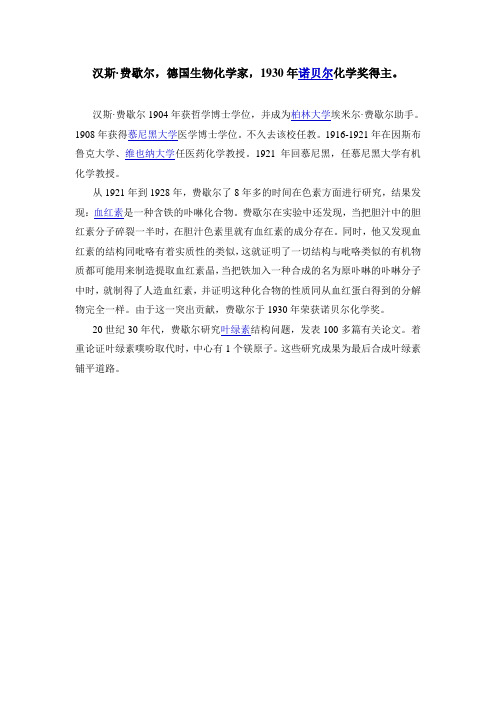
汉斯·费歇尔,德国生物化学家,1930年诺贝尔化学奖得主。
汉斯·费歇尔1904年获哲学博士学位,并成为柏林大学埃米尔·费歇尔助手。
1908年获得慕尼黑大学医学博士学位。
不久去该校任教。
1916-1921年在因斯布鲁克大学、维也纳大学任医药化学教授。
1921年回慕尼黑,任慕尼黑大学有机化学教授。
从1921年到1928年,费歇尔了8年多的时间在色素方面进行研究,结果发现:血红素是一种含铁的卟啉化合物。
费歇尔在实验中还发现,当把胆汁中的胆红素分子碎裂一半时,在胆汁色素里就有血红素的成分存在。
同时,他又发现血红素的结构同吡咯有着实质性的类似,这就证明了一切结构与吡咯类似的有机物质都可能用来制造提取血红素晶,当把铁加入一种合成的名为原卟啉的卟啉分子中时,就制得了人造血红素,并证明这种化合物的性质同从血红蛋白得到的分解物完全一样。
由于这一突出贡献,费歇尔于1930年荣获诺贝尔化学奖。
20世纪30年代,费歇尔研究叶绿素结构问题,发表100多篇有关论文。
着重论证叶绿素噗吩取代时,中心有1个镁原子。
这些研究成果为最后合成叶绿素铺平道路。
霍金Microsoft Word 文档

史蒂芬·威廉·霍金,英国名誉勋位,不列颠帝国勋章,皇家学会,英国皇家文艺学会(Stephen William Hawki,1942年1月8日-),英国物理学家,在公众评价中,被誉为是继爱因斯坦之后最杰出的理论物理学家之一。
他提出宇宙大爆炸自奇点开始,时间由此刻开始,黑洞最终会蒸发,在统一20世纪物理学的两大基础理论——爱因斯坦的相对论和普朗克的量子论方面走出了重要一步。
患有肌萎性侧索硬化症(ALS)的他,近乎全身瘫痪,不能发音,但1988年仍出版《时间简史》,至今已出售逾1000万册,成为全球最畅销的科普著作之一。
研究生英语阅读教程(提高版)第三版第六课原文

研究⽣英语阅读教程(提⾼版)第三版第六课原⽂A Beautiful MindSylvia Nasar[1]John Forbes Nash, Jr. —mathematical genius, inventor of a theory of rational behavior, visionary of the thinking machine —had been sitting with his visitor, also a mathematician, for nearly half an hour. It was late on a weekday afternoon in the spring of 1959, and, though it was only May, uncomfortably warm. Nash was slumped in an armchair in one corner of the hospital lounge, carelessly dressed in a nylon shirt that hung limply over his unbelted trousers. His powerful frame was slack as a rag doll’s, his finely molded features expressionless. He had been staring dully at a spot immediately in front of the left foot of Harvard professor George Mackey, hardly moving except to brush his long dark hair away from his forehead in a fitful, repetitive motion. His visitor sat upright, oppressed by the silence, acutely conscious that the doors to the room were locked. Mackey finally could contain himself no longer. His voice was slightly querulous, but he strained to be gentle. “How could you,” began Mackey, “how could you, a mathematician, a man devoted to reason and logical proof... how could you believe that extraterrestrials are sending you messages? How could you believe that you are being recruited by aliens from outer space to save the world? How could you ...?”[2]Nash looked up at last and fixed Mackey with an unblinking stare as cool and dispassionate as that of any bird or snake.“Because,” Nash said slowly in his soft, reasonable southern drawl, as if talking to himself, “the ideas I had about supernatural beings came to me the same way that my mathematical ideas did. So I took them seriously.”[3]The young genius from Bluefield, West Virginia—handsome, arrogant, and highly eccentric—burst onto the mathematical scene in 1948. Over the next decade, a decade as notable for its supreme faith in human rationality as for its dark anxieties about mankind's survival, Nash proved himself, in the words of the eminent geometer Mikhail Gromov, “the most remarkable mathematician of the second half of the century.”Games of strategy, economic rivalry, computer architecture, the shape of the universe, the geometry of imaginary spaces, the mystery of prime numbers—all engaged his wide-ranging imagination. His ideas were of the deep and wholly unanticipated kind that pushes scientific thinking in new directions.[4]Geniuses, the mathematician Paul Halmos wrote, “are of two kinds: the ones who are just like all of us, but very much more so, and the ones who, apparently, have an extra human spark. We can all run, and some of us can run the mile in less than 4 minutes; but there is nothing that most of us can do that compares with the creation of the Great G-minor Fugue.”Nash’s genius was of that mysterious variety more often associated with music and art than with the oldest of all sciences. It wasn’t merely that his mind worked faster, that his memory was more retentive, or that his power of concentration was greater. The flashes of intuition were nonrational. Like other great mathematical intuitionists —Georg Friedrich Bernhard Riemann, Jules Henri Poincare, Srinivasa Ramanujan—Nash saw the vision first, constructing the laborious proofs long afterward. But even after he’d try to explain some astonishing result, the actual route he had taken remained a mystery to others who tried to follow his reasoning. Donald Newman, a mathematician who knew Nash at MIT in the 1950s, used to say about him that “everyone else would climb a peak by looking for a path somewhere on the mountain. Nash would climb another mountain altogether and from that distant peak would shine a searchlight back onto the first peak”[5]No one was more obsessed with originality, more disdainful of authority, or more jealous of his independence. As a young man he was surrounded by the high priests of twentieth-century science—Albert Einstein, John von Neumann, and Norbert Wiener—he joined no school, became no one's disciple, got along largely without guides or followers. In almost everything he did—from game theory to geometry—he thumbed his nose at the received wisdom, current fashions, established methods. He almost always worked alone, in his head, usually walking, often whistling Bach. Nash acquired his knowledge of mathematics not mainly from studying what other mathematicians had discovered, but by rediscovering their truths for himself. Eager to astound, he was always on the lookout for the really big problems. When he focused on some new puzzle, he saw dimensions that people who really knew the subject (he never did) initially dismissed as naive or wrongheaded. Even as a student, his indifference to others' skepticism, doubt, and ridicule was awesome.[6]Nash’s faith in rationality and the power of pure thought was extreme, even for a very young mathematician and even for the new age of computers, space travel, and nuclear weapons. Einstein once chided him for wishing to amend relativity theory without studying physics. His heroes were solitary thinkers and supermen like Newton and Nietzsche. Computers and science fiction were his passions. He considered “thinking machines”, as he called them, superior in some ways to human beings. At one point, he became fascinated by the possibility that drugs could heighten physical and intellectual performancedd9 He was beguiled by the idea of alien races of hyper-rational beings who had taught themselves to disregard all emotion. 10 Compulsively rational, he wished to turn life’s decisions—whether to take the first elevator or wait for the next one, where to bank his money, what job to accept, whether to marry—into calculations of advantage and disadvantage, algorithms or mathematical rules divorced from emotion, convention, and tradition. Even the small act of saying an automatic hello to Nash in a hallway could elicit a furious “Why are you saying hello to me?”[7]His contemporaries, on the whole, found him immensely strange. They described him as “aloof ”, “haughty”, “without affect”, “detached”, “spooky”, “isolated”and “queer”, Nash mingled rather than mixed with his peers. Preoccupied with his own private reality, he seemed not to share their mundane concerns. His manner—slightly cold, a bit superior, somewhat secretive—suggested something “mysterious and unnatural”. His remoteness was punctuated by flights of grrulousness about outer space and geopolitical trends, childish pranks, and unpredictable eruptions of anger. But these outbursts were, more often than not, as enigmatic as his silences. “He is not one of us”was a constant refrain. Amathematician at the Institute for Advanced Study remembers meeting Nash for the first time at a crowded student party at Princeton:I noticed him very definitely among a lot of other people who were there. He was sitting on the floor in a half-circle discussing something. He made me feel uneasy. He gave me a peculiar feeling. I had a feeling of a certain strangeness. He was different in some way. I was not aware of the extent of his talent. I had no idea he would contribute as much as he really did.[8]But he did contribute, in a big way. The marvelous paradox was that the ideas themselves were not obscure. In 1958, Fortune singled Nash out for his achievements in game theory, algebraic geometry, and nonlinear theory, calling him the most brilliant of the younger generation of new ambidextrous mathematicians who worked in both pure and applied mathematics. Nash's insight into the dynamics of human rivalry —his theory of rational conflict and cooperation —was to become one of the most influential ideas of the twentieth century, transforming the young science of economics the way that Mendel’s ideas of genetic transmission, Darwin’s model of natural selection, and Newton’s celestial mechanics reshaped biology and physics in their day.。
《身体从未忘记》巴塞尔·范德考克

失忆、解离和重现
五、几种疗愈创伤的方法
对于PTSD患者而言,时间不会冲淡一切,唯有夺回自我控制权,才能疗愈所有的心理创伤。作者将这种控制 自我的能力称为“自我领导力”。 疗愈的原理 治疗创伤的最大挑战是重新建立你对自我(即身体和思维)的控制,不再被过去的事情和感受困扰,不再感到 不堪重负、愤怒、羞愧和崩溃。
1.当我们受到威胁时,我们就会自动进入我们的第一种状态,社ቤተ መጻሕፍቲ ባይዱ参与。我们会向我们周围的人求助、 呼救、寻求安慰。
2.如果没有人响应我们,或我们面临立即到来的伤害时,我们的身体会转换到一种更原始的求生方式: 战斗或逃跑。我们击退攻击,或者跑到一个安全的地方。
3.如果这些策略都失败了,我们无法逃避,或被抓住了,我们的身体会为了保存自己而尽量节省能源、 关闭一切不必要的功能。这种状态称为惊呆或崩溃。
眼动脱敏和再加工(EMDR)治疗 EMDR是一种整合创伤性材料的治疗方式,几乎不需要自我意识的参与,疗法过程中心 理咨询师需要在病人眼前不断晃动手指。它不仅仅着重于调整强烈的创伤性记忆,也专 注于通过重新掌握身体和思维恢复自主性、参与感和责任感。 三个特征: A:EMDR可以使大脑中的某种东西变得松散,从而使人们快速地回忆起过去经历的片段 和画面,而且这些经历往往并不是紧密关联的。这似乎有助于让人们从更全面的角度看 待自己的创伤。 B:人们或许可以不用说出创伤经历而达到治愈的效果。EMDR提供了一种帮助病人审视 过去经历的方法,和传统的叙述与倾听方式截然不同。 C:即使病人和医生之间没有信任关系,EMDR也可以起到很好的治疗作用。
而创伤康复的根本工具之一,就是学习做到即使是在接触痛苦和可怕的回忆时,都能平静地 呼吸,而且有意识地保持一定程度的身体放松。
人际关系
译林版七年级下册英语第2单元作文

全文分为作者个人简介和正文两个部分:作者个人简介:Hello everyone, I am an author dedicated to creating and sharing high-quality document templates. In this era of information overload, accurate and efficient communication has become especially important. I firmly believe that good communication can build bridges between people, playing an indispensable role in academia, career, and daily life. Therefore, I decided to invest my knowledge and skills into creating valuable documents to help people find inspiration and direction when needed.正文:译林版七年级下册英语第2单元作文全文共3篇示例,供读者参考篇1My Journey of Self-Discovery Through ReadingReading has been a constant companion in my life, a gateway to knowledge, imagination, and self-exploration. As Ireflect on my journey with books, I can't help but marvel at how they have shaped my understanding of the world and myself.From an early age, I was fascinated by the stories that unfolded within the pages of picture books. The vibrant illustrations and captivating tales transported me to worlds far beyond my immediate surroundings. I vividly remember sitting on my mother's lap, listening intently as she brought the characters to life with her expressive voice. Those moments instilled in me a profound love for reading and a curiosity that yearned to be satiated.As I grew older, my literary adventures evolved. I delved into chapter books, immersing myself in narratives that challenged my perspectives and broadened my horizons. I discovered the magic of fantasy realms, where brave heroes embarked on epic quests, and the complexities of real-life dramas that mirrored the intricacies of human relationships. Each book became a portal to new experiences, inviting me to step into the shoes of diverse characters and explore the depths of their emotions, motivations, and struggles.One book that left an indelible mark on me was "To Kill a Mockingbird" by Harper Lee. Through the innocent eyes of Scout Finch, I witnessed the harsh realities of prejudice and injusticethat plagued society. It was a poignant reminder of the importance of empathy, courage, and standing up for what is right, even in the face of adversity. This book ignited a passion within me to advocate for equality and champion the voices of those who are often silenced.Reading also opened my eyes to the richness of different cultures and perspectives. I immersed myself in tales from distant lands, learning about traditions, beliefs, and ways of life that differed from my own. Books like "The Kite Runner" by Khaled Hosseini and "Persepolis" by Marjane Satrapi provided me with a glimpse into the complexities of the Middle Eastern experience, challenging my preconceived notions and fostering a deeper understanding and appreciation for diversity.As I navigated the teenage years, a time often fraught with self-doubt and identity exploration, books became a sanctuary where I could find solace and guidance. The characters I encountered often mirrored my own struggles, fears, and aspirations, offering solace in knowing that I was not alone in my journey. Novels like "The Perks of Being a Wallflower" by Stephen Chbosky and "The Fault in Our Stars" by John Green resonated with me on a profound level, validating my emotions and reminding me of the resilience of the human spirit.Reading has also been a catalyst for personal growth and self-reflection. Thought-provoking works of non-fiction, such as "Man's Search for Meaning" by Viktor Frankl and "The Power of Habit" by Charles Duhigg, challenged me to examine my beliefs, habits, and perspectives. They prompted me to question societal norms and encouraged me to cultivate a growth mindset, embracing the idea that change and self-improvement are always possible.Moreover, reading has been an invaluable companion in my academic pursuits. From Shakespeare's timeless plays to the scientific marvels explored in "A Brief History of Time" by Stephen Hawking, books have enriched my understanding of various subjects and ignited a thirst for knowledge that transcends the classroom walls.As I look ahead, I am filled with excitement at the prospect of the literary adventures that await me. I know that with each book I open, I embark on a journey of self-discovery, expanding my horizons and shaping the person I aspire to become. Reading has been, and will continue to be, a profound source of inspiration, enlightenment, and personal growth.In a world that often moves at a frenetic pace, books offer a sanctuary where I can slow down, immerse myself in captivatingnarratives, and contemplate the complexities of the human experience. They have become a cherished companion, a confidant that whispers words of wisdom and encouragement, and a compass guiding me towards a deeper understanding of myself and the world around me.To those who have yet to discover the magic of reading, I extend an invitation to embark on this extraordinary journey. Open a book, and let the words transport you to realms beyond imagination, challenge your perspectives, and ignite a fire within you that burns with curiosity and a thirst for knowledge. For within the pages of a book lies the key to unlocking the boundless potential of the human mind and spirit.篇2Unit 2: A Brilliant MindWhen I first opened up to Unit 2 in our Yilin 7th grade English textbook, I was really excited to learn about the famous scientist Stephen Hawking. I had heard his name before and knew he was super smart, but I didn't know much about his life and work. As I read through the unit, I was totally blown away by Hawking's incredible story.The first thing that struck me was how difficult Hawking's life has been from the very beginning. He was diagnosed with a rare motor neuron disease called ALS when he was just 21 years old. The doctors gave him only a few years to live at the time. But despite this devastating news, Hawking refused to give up. He kept pushing forward with his groundbreaking research in theoretical physics and cosmology.Can you imagine being told you only have a couple of years left to live when you're just starting out as an adult? I can't even fathom having that kind of strength and resilience. Hawking's determination in the face of such a heartbreaking diagnosis is just unbelievable to me. It's one of the most inspiring stories I've ever learned about.As the disease progressed, Hawking became almost entirely paralyzed and lost his ability to speak. But even that couldn't stop his brilliant mind. With the help of a computerized voice system, he continued lecturing, writing books, and making major contributions to our understanding of the universe. His book A Brief History of Time made complicated physics concepts accessible to ordinary people like me. The visuals and examples in our textbook really helped me grasp some of the key ideas he discovered, like black holes and the Big Bang theory.What I find so amazing about Stephen Hawking is that his body was trapped in this deteriorating state, but his mind was still soaring, exploring the deepest mysteries of our cosmos. He is living proof that our physical limitations don't have to limit our intellectual potential. Despite being almost entirely paralyzed for decades, Hawking made groundbreaking discoveries that changed how we view black holes, gravity, space and time itself. That's the true power of an unstoppable mind.Hawking didn't just radically advance our scientific knowledge though - he also spent so much time and energy communicating these complex ideas to the rest of the world. From giving lectures all over the globe to writing bestselling books, he used his brilliant mind to spread knowledge, educate, and inspire. He had this amazing ability to take mind-bendingly difficult physics concepts and make them understandable to regular people. I'm so grateful our English textbook included excerpts from his writing because it gave me a window into how he thought about and described the universe.I'll never forget learning about Hawking's life story and work in Unit 2. His journey of perseverance, resilience and unwavering intellectual curiosity has motivated me to work harder and never give up, no matter how difficult life gets. Hawking showed thatour minds and determination are really the only true limits on what we can achieve. If a man who can barely move or speak can reshape our understanding of the cosmos, then I have no excuses for not giving my all and chasing my dreams.I feel so fortunate that our textbook included this incredible scientist and role model. Reading about Hawking's battles with his devastating disease, his paradigm-shifting theories, his lifelong quest for knowledge, and his impact on the world has expanded my mind in so many ways. His story is proof that we should never stop learning, never stop being curious, and never stop pushing the boundaries of what's possible. I know I'll carry the lessons and inspiration from Stephen Hawking with me for the rest of my life.篇3My Dream Summer VacationI can't wait for summer vacation! School has been really hard this year with so many tests and homework assignments. Don't get me wrong, I actually like learning new things. But sometimes it feels like my brain is going to explode from information overload. That's why I'm so excited for the long summer breakcoming up. No school, no studying, no tests! Just pure freedom and fun for over two months.My parents already promised we can go on an awesome vacation this summer since I worked really hard and got good grades. I've been researching different destinations and made a PowerPoint presentation to convince them where we should go. After looking at my totally professional slides (I learned how to use PowerPoint in computer class), they agreed to take us to...Bali! Yeah, I did a little happy dance when they said yes.Bali has been #1 on my dream vacation list for years. It's this beautiful island in Indonesia with beaches, volcanoes, tropical forests, and unique Hindu culture. From what I've seen in photos and videos, it looks like a real-life paradise. The scenery there is just breathtaking. I can picture us relaxing on pristine white sand beaches, going snorkeling to see the amazing coral reefs, hiking through lush jungles, and visiting ancient Hindu temples. It combines adventure, nature, and culture all in one place. The perfect summer getaway!Of course, part of me is also really excited about the hotel we'll be staying at. My parents booked us a villa at this incredible resort right on the beach in an area called Nusa Dua. The photos make it look like a slice of heaven. We'll have our own privatepool, beautiful rooms, and direct access to the beach. The resort has multiple pools, restaurants, a spa, activities like yoga and Balinese dance classes...basically everything you could want for an ultra-luxurious vacation experience. I'm mostly just excited to sleep in as late as I want without my mom yelling at me!While the resort looks amazing, I actually want to get out and explore a lot of Bali rather than spending the whole trip laying around. I've already made a long list of all the places I want to visit and things I want to do. At the top is hiking up Mount Batur, an active volcano with awesome views from the summit. I read that you have to start the hike around 4am to make it up by sunrise, which sounds super cool. I also really want to go whitewater rafting down the Ayung River and explore the Sacred Monkey Forest, which is full of playful monkeys just roaming around ancient mossy temples.For more cultural activities, I've read that watching a Balinese dance performance is a must. The dances tell traditional stories through very precise movements and elaborate costumes. We also have to visit Tanah Lot, which is this photogenic Hindu temple perched on a rocky islet surrounded by crashing waves. I've seen so many iconic pictures of it. And of course, no trip to Bali would be complete without seeing the famous stepped riceterraces that look like lush green stairways carved into the hillsides.I know we'll have to try lots of delicious Balinese food as well. I've watched videos about some of the signature dishes like babi guling (suckling pig), bebek betutu (smoked duck), and lawar (vegetable salad with pork and shrimp). It all looks so flavorful and different than what we're used to eating at home. I definitely want to take a cooking class to learn how to make some of the traditional dishes myself. We may have to avoid some of the super spicy stuff though because my dad can't handle very spicy foods (what a wuss!)In between all the activities and sightseeing, I'm sure we'll find time to just chill at the beach or pool and do nothing at all. After the craziness of this school year, I am so ready to spend entire days napping in a shaded cabana, reading stupid magazines, playing games on my Nintendo Switch, and snacking on weird tropical fruits I've never heard of. Those blissfully lazy days are part of what makes a real vacation so relaxing.The only part I'm not looking forward to is the incredibly long flights to get to Bali. It's going to take over 20 hours of travel from our city! I get antsy just sitting through a 2-hour movie, so I have no idea how I'll survive over 20 hours onairplanes. My parents suggested taking medications to help me sleep through most of it, but I hate that groggy feeling when you wake up from Sleeping pills. I guess I'll just have to load up my portable charger, queue up a ton of shows and movies, and make sure to get up and walk around a lot.Seriously though, the long journey will be worth it to spend over 2 weeks in paradise. Part of me will probably cry when it's time to leave Bali and come back home. But I'll also be coming home with a ton of amazing photos, videos, and memories that I'll get to keep forever. Who knows, this could be the first of many trips to different parts of Indonesia over my lifetime! For now though, I just have to focus on finishing up this school year. After that...see you in Bali!。
细胞凋亡和疾病

细胞凋亡和疾病
37/47
Bcl-2相关X蛋白(Bax)
同源二聚体
异源二聚体
细胞凋亡和疾病
38/47
细胞凋亡和疾病
39/47
p53
• 抑癌基因 • “分子警察” • DNA结合蛋白
• 促进凋亡:
– 经过诱导Bax基因、 Apaf-1 表示来促进细 胞凋亡
射线,化疗药,氧化应激,钙稳态失衡→开放.
细胞凋亡和疾病
31/47
• 凋亡诱导因子
– 细胞色素C (cytochrome C, Cyto-C)
– 凋亡诱导因子(apoptosis inducing factor, AIF) – 凋亡蛋白酶激活因子(apoptosis protease
activating factor, Apaf)
– Cyto-C释放,激活 Caspase
细胞凋亡和疾病
40/47
细胞凋亡与疾病
凋亡不足
肿瘤 本身免疫病 病毒感染
凋亡过分
凋亡不足+凋亡过分
心血管疾病: 心肌缺血
缺血-再灌注损伤 血液系统疾病: 贫血,再障,慢性嗜中性粒
细胞降低
AIDS
动脉粥样硬化(AS)
细胞凋亡和疾病
41/47
细胞凋亡不足
• 肿瘤
细胞凋亡和疾病
5/47
2.形态学改变
细胞凋亡和疾病
6/47
电子显微镜
细胞凋亡和疾病
7/47
细胞凋亡和疾病
8/47
细胞凋亡和疾病
9/47
坏死
凋亡
性质
诱导原因 形态改变
病理性
美国心里学家考夫关于记忆表象的实验
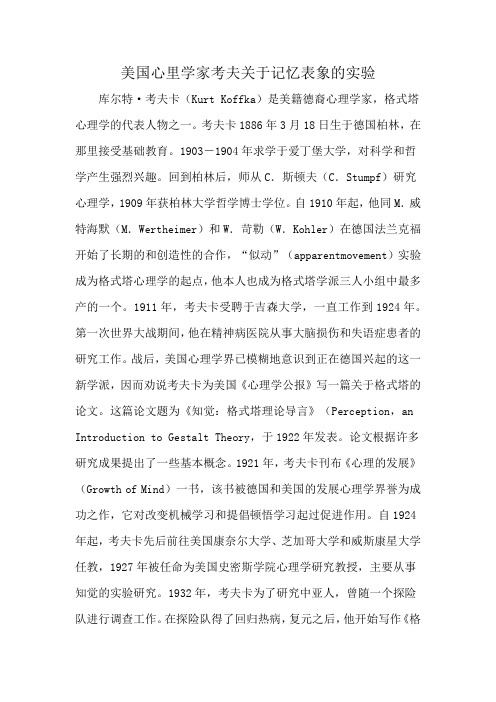
美国心里学家考夫关于记忆表象的实验库尔特·考夫卡(Kurt Koffka)是美籍德裔心理学家,格式塔心理学的代表人物之一。
考夫卡1886年3月18日生于德国柏林,在那里接受基础教育。
1903-1904年求学于爱丁堡大学,对科学和哲学产生强烈兴趣。
回到柏林后,师从C.斯顿夫(C.Stumpf)研究心理学,1909年获柏林大学哲学博士学位。
自1910年起,他同M.威特海默(M.Wertheimer)和W.苛勒(W.Kohler)在德国法兰克福开始了长期的和创造性的合作,“似动”(apparentmovement)实验成为格式塔心理学的起点,他本人也成为格式塔学派三人小组中最多产的一个。
1911年,考夫卡受聘于吉森大学,一直工作到1924年。
第一次世界大战期间,他在精神病医院从事大脑损伤和失语症患者的研究工作。
战后,美国心理学界已模糊地意识到正在德国兴起的这一新学派,因而劝说考夫卡为美国《心理学公报》写一篇关于格式塔的论文。
这篇论文题为《知觉:格式塔理论导言》(Perception,an Introduction to Gestalt Theory,于1922年发表。
论文根据许多研究成果提出了一些基本概念。
1921年,考夫卡刊布《心理的发展》(Growth of Mind)一书,该书被德国和美国的发展心理学界誉为成功之作,它对改变机械学习和提倡顿悟学习起过促进作用。
自1924年起,考夫卡先后前往美国康奈尔大学、芝加哥大学和威斯康星大学任教,1927年被任命为美国史密斯学院心理学研究教授,主要从事知觉的实验研究。
1932年,考夫卡为了研究中亚人,曾随一个探险队进行调查工作。
在探险队得了回归热病,复元之后,他开始写作《格式塔心理学原理》(The Principle of Gestalt Psychology),该书由纽约哈考特-布雷斯-约万诺维奇公司于1935年出版。
这是一部意欲集格式塔心理学之大成的著作,但是极其难读,史界对此贬褒不一。
A02-一个数学家的辨白
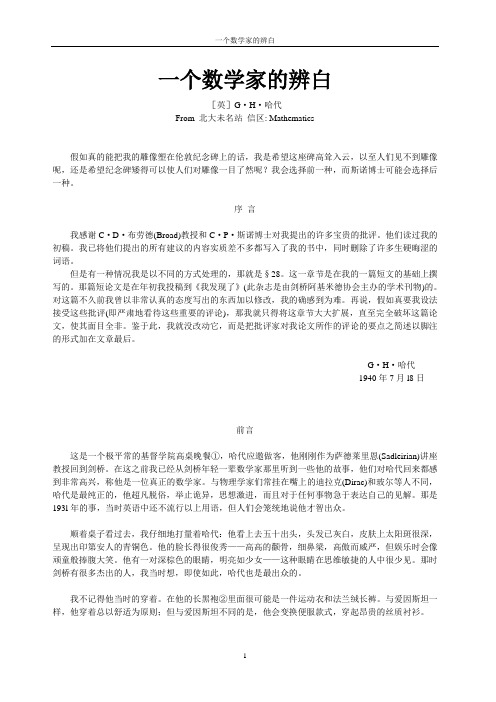
一个数学家的辨白[英]G·H·哈代From 北大未名站信区: Mathematics假如真的能把我的雕像塑在伦敦纪念碑上的话,我是希望这座碑高耸入云,以至人们见不到雕像呢,还是希望纪念碑矮得可以使人们对雕像一目了然呢?我会选择前一种,而斯诺博士可能会选择后一种。
序言我感谢C·D·布劳德(Broad)教授和C·P·斯诺博士对我提出的许多宝贵的批评。
他们读过我的初稿。
我已将他们提出的所有建议的内容实质差不多都写入了我的书中,同时删除了许多生硬晦涩的词语。
但是有一种情况我是以不同的方式处理的,那就是§28。
这一章节是在我的一篇短文的基础上撰写的。
那篇短论文是在年初我投稿到《我发现了》(此杂志是由剑桥阿基米德协会主办的学术刊物)的。
对这篇不久前我曾以非常认真的态度写出的东西加以修改,我的确感到为难。
再说,假如真要我设法接受这些批评(即严肃地看待这些重要的评论),那我就只得将这章节大大扩展,直至完全破坏这篇论文,使其面目全非。
鉴于此,我就没改动它,而是把批评家对我论文所作的评论的要点之简述以脚注的形式加在文章最后。
G·H·哈代1940年7月l8日前言这是一个极平常的基督学院高桌晚餐①,哈代应邀做客,他刚刚作为萨德莱里恩(Sadleirian)讲座教授回到剑桥。
在这之前我已经从剑桥年轻一辈数学家那里听到一些他的故事,他们对哈代回来都感到非常高兴,称他是一位真正的数学家。
与物理学家们常挂在嘴上的迪拉克(Dirac)和玻尔等人不同,哈代是最纯正的,他超凡脱俗,举止诡异,思想激进,而且对于任何事物急于表达自己的见解。
那是193l年的事,当时英语中还不流行以上用语,但人们会笼统地说他才智出众。
顺着桌子看过去,我仔细地打量着哈代:他看上去五十出头,头发已灰白,皮肤上太阳斑很深,呈现出印第安人的青铜色。
他的脸长得很俊秀——高高的颧骨,细鼻梁,高傲而威严,但娱乐时会像顽童般捧腹大笑。
【课外阅读】美国华裔最新发现神经病理学致病基因特质
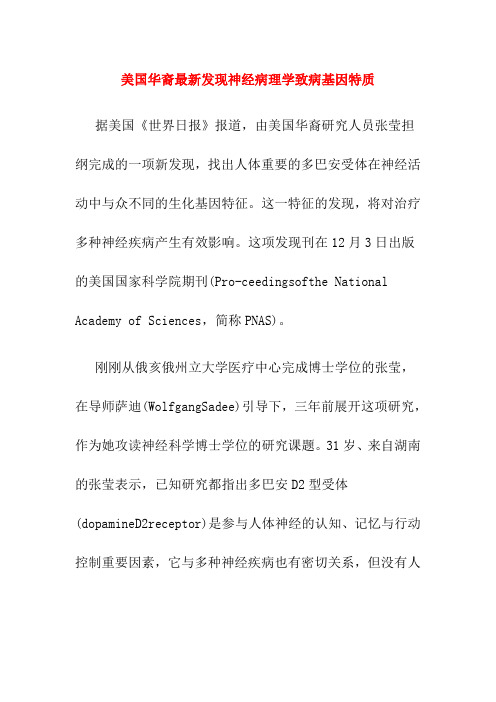
美国华裔最新发现神经病理学致病基因特质据美国《世界日报》报道,由美国华裔研究人员张莹担纲完成的一项新发现,找出人体重要的多巴安受体在神经活动中与众不同的生化基因特征。
这一特征的发现,将对治疗多种神经疾病产生有效影响。
这项发现刊在12月3日出版的美国国家科学院期刊(Pro-ceedingsofthe National Academy of Sciences,简称PNAS)。
刚刚从俄亥俄州立大学医疗中心完成博士学位的张莹,在导师萨迪(WolfgangSadee)引导下,三年前展开这项研究,作为她攻读神经科学博士学位的研究课题。
31岁、来自湖南的张莹表示,已知研究都指出多巴安D2型受体(dopamineD2receptor)是参与人体神经的认知、记忆与行动控制重要因素,它与多种神经疾病也有密切关系,但没有人知道它与上述因素的具体关系,也没有人知道这一受体与其它神经组织的不同。
为发现该受体的特别之处,萨迪把这项任务交给张莹,并与俄大统计系教授李美玲(Mei-LingLee,译音)、博士生萧涛(TaoXiao)和实验室研究员王丹心(Danxin Wang)以及AudreyPapp等配合研究。
张莹指出,经过近四年的筛选性研究,她最终发现多巴安受体有个与众不同的基因特质(bio-marker):一种单核甘酸多型性(SNPs)的存在,影响着受体的基因表达,因而影响精神分裂症、帕金森氏症和嗜毒等脑神经疾病对药物的反馈。
萨迪指出,找到这种受体的基因特征,将可以更有效地发现上述脑神经疾病的对抗疗法。
在不了解这些疾病的特质时,有的药物对这些疾病有效,有的则没效,但在服用本来无效的药物期间,患者可能遭受其它的损伤。
张莹表示,这一发现可以对部分精神疾病患诊断、乃至未来的治疗有一定的指导作用。
〖医学〗1995年诺贝尔生理学或医学奖获得者发现了早期胚胎发育的遗传控制

565-570.
• 1992
Lewis, E. B. Clusters of master control genes regulate the development of higher organisms. The 1991 Albert Lasker Medical Awards. JAMA 267:1524-1531.
需要一组相关基因的协调表现
• 某一体位的突变,暗示著一个主调控基因
(master regulator gene)的存在
• 此基因关键性地启闭或选择身体某部位的
发育途径
•Nusslein-Volhard和
Wieshaus 的研究
• 1978年两人联手在海德堡的欧洲分子生物
实验室有系统地搜寻控制胚胎早期发育的 起始基因
中医即中国传统医药学,是形成于 数千年 前的中 国,是 建立在 人们与 疾病长 期斗争 的经验 总结。 习樟恕 9食鱿 治饕蕉 灾瘟撇 涣说募 膊≈
至于循证医学、比较医学、后现代医 学、行 为医学 等所谓 “医学 ”,都 称不上 一门独 立的医 学科学 ,关于 这一点 在灵魂 医学有 关章节 中将有 相关点 评。
• 整理出胚胎发育5000个重要的基因和139个
必要的基因
• 最终确认了100个以上,大部份是以前未曾发
现的,控制胚胎最早发育的基因
•三位科学家对发育遗传学的
研究,对敲开人类发育遗传秘 密的大门,并使之应用到人类 疾病的诊断意义重大
本文档下载后可以修改编辑,欢迎下载收藏。
,成为世界医学史上的主流。
西医学是最近三四百年来建立在解剖学 、生物 学及现 代科学 技术基 础上、 发展起 来的一 门以“ 解剖人 、肉体 人”为 概念的 、新兴 的现代 医学科 学理论 体系。 主要采 用科学 实验方 法,从 宏观到 微观, 直至目 前的分 子基因 层次水 平,发 展极为 迅速, 超过其 它任何 一门医 学科学 决目
学术英语(医学)教师版Unit2课文翻译
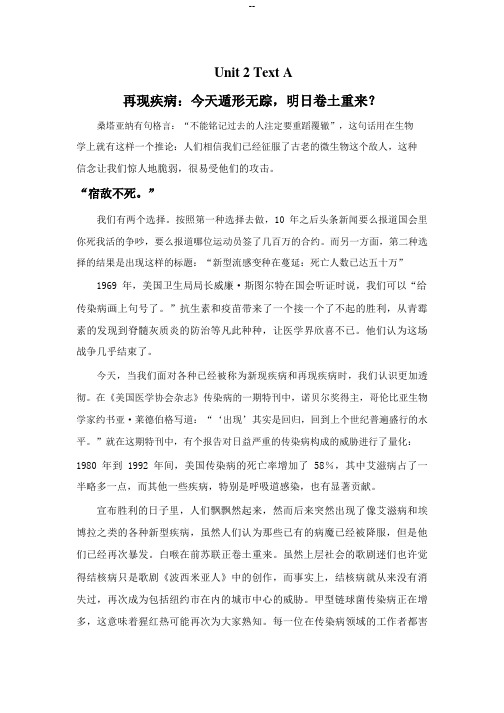
Unit 2 Text A再现疾病:今天遁形无踪,明日卷土重来?桑塔亚纳有句格言:“不能铭记过去的人注定要重蹈覆辙”,这句话用在生物学上就有这样一个推论:人们相信我们已经征服了古老的微生物这个敌人,这种信念让我们惊人地脆弱,很易受他们的攻击。
“宿敌不死。
”我们有两个选择。
按照第一种选择去做,10 年之后头条新闻要么报道国会里你死我活的争吵,要么报道哪位运动员签了几百万的合约。
而另一方面,第二种选择的结果是出现这样的标题:“新型流感变种在蔓延:死亡人数已达五十万”1969 年,美国卫生局局长威廉·斯图尔特在国会听证时说,我们可以“给传染病画上句号了。
”抗生素和疫苗带来了一个接一个了不起的胜利,从青霉素的发现到脊髓灰质炎的防治等凡此种种,让医学界欣喜不已。
他们认为这场战争几乎结束了。
今天,当我们面对各种已经被称为新现疾病和再现疾病时,我们认识更加透彻。
在《美国医学协会杂志》传染病的一期特刊中,诺贝尔奖得主,哥伦比亚生物学家约书亚·莱德伯格写道:“‘出现’其实是回归,回到上个世纪普遍盛行的水平。
”就在这期特刊中,有个报告对日益严重的传染病构成的威胁进行了量化:1980 年到 1992 年间,美国传染病的死亡率增加了 58%,其中艾滋病占了一半略多一点,而其他一些疾病,特别是呼吸道感染,也有显著贡献。
宣布胜利的日子里,人们飘飘然起来,然而后来突然出现了像艾滋病和埃博拉之类的各种新型疾病,虽然人们认为那些已有的病魔已经被降服,但是他们已经再次暴发。
白喉在前苏联正卷土重来。
虽然上层社会的歌剧迷们也许觉得结核病只是歌剧《波西米亚人》中的创作,而事实上,结核病就从来没有消失过,再次成为包括纽约市在内的城市中心的威胁。
甲型链球菌传染病正在增多,这意味着猩红热可能再次为大家熟知。
每一位在传染病领域的工作者都害怕,终有一日一种强大的新型流感菌株会席卷全球。
“战争胜利了,” 最近有位科学家嘲弄道,“是对方(传染病)获胜。
日发现一种能推迟渐冻症发展的蛋白质
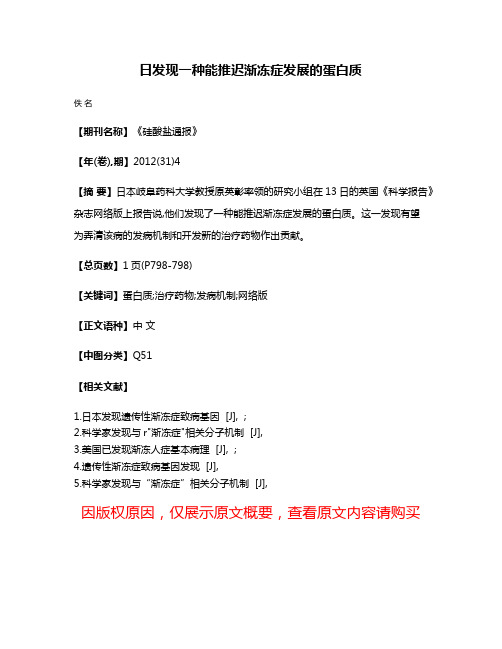
日发现一种能推迟渐冻症发展的蛋白质
佚名
【期刊名称】《硅酸盐通报》
【年(卷),期】2012(31)4
【摘要】日本岐阜药科大学教授原英彰率领的研究小组在13日的英国《科学报告》杂志网络版上报告说,他们发现了一种能推迟渐冻症发展的蛋白质。
这一发现有望
为弄清该病的发病机制和开发新的治疗药物作出贡献。
【总页数】1页(P798-798)
【关键词】蛋白质;治疗药物;发病机制;网络版
【正文语种】中文
【中图分类】Q51
【相关文献】
1.日本发现遗传性渐冻症致病基因 [J], ;
2.科学家发现与r"渐冻症"相关分子机制 [J],
3.美国已发现渐冻人症基本病理 [J], ;
4.遗传性渐冻症致病基因发现 [J],
5.科学家发现与“渐冻症”相关分子机制 [J],
因版权原因,仅展示原文概要,查看原文内容请购买。
- 1、下载文档前请自行甄别文档内容的完整性,平台不提供额外的编辑、内容补充、找答案等附加服务。
- 2、"仅部分预览"的文档,不可在线预览部分如存在完整性等问题,可反馈申请退款(可完整预览的文档不适用该条件!)。
- 3、如文档侵犯您的权益,请联系客服反馈,我们会尽快为您处理(人工客服工作时间:9:00-18:30)。
Furstenberg’s proof of long arithmetic progressions:Introduction to Roth’s TheoremSteven ButlerUniversity of California,San DiegoNovember4,2004These are the notes for thefirst of a pair of lectures that will outline a proof given by Hillel Furstenberg[3]for the existence of long arithmetic progressions in sets of integers with positive upper density,a resultfirst proved by Szemer´e di[8].1History of long arithmetic progressionsThefirst major result in the theory of long arithmetic progressions was due to van der Waerden in1927[9].Theorem(van der Waerden).Given any partition of the positive integers intofinitely many sets B1,...,B k,then at least one of the B i contains arithmetic progressions of arbitrary length.In the1930’s Erd˝o s and Tur´a n[2]conjectured that for a set to have arbitrarily long arithmetic progressions that it needed to be asymptotically dense.Specifically,any set with positive upper density should have arbitrarily long arithmetic progressions.Definition(See[4],p.72).A set B is said to have positive upper Banach density if and only if|B∩I|lim sup|I|→∞The definition for positive upper density is similar,only in that case we restrict ourselves to intervals of the form[1,n].Clearly any set with positive upper Banach density has positive upper density.The proof by Furstenberg will show that any set with positive upper Banach density will have long arithmetic progressions.[Note that in van der Waerden’s theorem at least one of the B i must have positive upper density,and so the conjecture by Erd˝o s and Tur´a n is a stronger claim.]Roth in1952[6]established that any set with positive upper density contains an arithmetic progression of length three.Szemer´e di in1969[7]established the result for arithmetic progressions of length four and in1975[8]established the result for arithmetic progressions of arbitrary length using combinatorial arguments.Theorem(Szemer´e di).Any set of integers having positive upper density contains arith-metic progressions of arbitrary length.Shortly after Szemer´e di established the result,Furstenberg in1977[3]established the result by translating it into a measure theoretic question and then used ergodic theory.2A quick introduction to ergodic theoryErgodic theory deals with the study of long term average behavior of dynamical systems. The principle being that“behavior on the average is easier to control”.The setting for ergodic theory is(X,B,µ,T)where X is the space,B is aσ-algebra of sets for the space(these represent the measurable sets of X),µis afinite measure(i.e.,µ(X)<∞, by scaling we can,and will,assume thatµ(X)=1so that we are dealing with a probability measure),and T:X→X is a measure preserving transformation.Definition.We say T:X→X is a measure preserving transformation if for every A∈B we have thatµ(A)=µ(T−1A).Further,we say that a measure preserving transformation is ergodic if A=T−1(A)implies thatµ(A)=0orµ(A)=1.Note,we do not require that T be invertible,in which case we may not haveµ(A)=µ(T A). Also,for any measure preserving transformation system we have that it can be decomposed into a collection of ergodic systems in a manner analogous to the fact that any permutation can be replaced by a product of cycles.Thefirst result in ergodic theory can be traced back to Poincar´e,which we will talk about below in relationship to two term arithmetic progressions.Birkhoffin1927[1]helpedfirm up the ideas about ergodic theory and is credited with the following early result in thefield. Theorem(Birkhoff).Consider the dynamical system(X,B,µ,T)where T is an ergodic map,and let f:X→R be a real-valued measurable function.Then for almost every x∈Xwe have that1limn→∞=µ(A),n+1i.e.,the average number of times that x shows up in A under T corresponds to the measure of A.Looking at(2)in another way we can use these sequences of averages to define an integral which in turn will define a measure.This will essentially be the idea when we construct an appropriate measure for our proof of Szemer´e di’s theorem.3Ergodic view of Szemer´e di’s theoremReturning to the problem offinding long arithmetic progressions,let us denote the shift map of integers by T,i.e.,T x→x+1,and let T m,m∈Z,denote repeated composition of the shift map.Then to say that B⊆Z contains an arithmetic progression of length k is equivalent to showing that for some n>0B∩T−n B∩T−2n B∩···∩T−(k−1)n B=0.To see this suppose that b lies in the intersection.Then since b∈T−n B that implies that b+n∈B,similarly b+2n,b+3n,...,b+(k−1)n∈B.The setb,b+n,b+2n,...,b+(k−1)nis the desired arithmetic progression.Examining our shift map we note that the only sets which are invariant under T−1is Z and ∅.At the same time,note that a set B has positive upper Banach density if and only if T−1B has positive upper Banach density.If we canfind some appropriate space and measure that takes these into account then we can use T as an ergodic map and then apply ergodic theory.4Constructing our measureWe start by lettingΩ={0,1}Z,i.e.,the space of all{0,1}-sequences.We can think of an element inΩas an indicator function for a subset of Z.Since{0,1}is compact then by Tychonoff’s Theorem we have thatΩis compact,further it has a corresponding metric. Also,let T:Ω→Ωbe the shift map,i.e.,Tω(n)=ω(n+1).For an elementξ∈Ωwe say that1occurs with positive upper Banach density if the set {n∈Z|ξ(n)=1}has positive upper Banach density.In particular,if B is a set which has positive upper Banach density then1occurs with positive upper Banach density inξ=1B. There turns out to be a correlation between sets with positive upper Banach density and T-invariant measures.Lemma(See[4],p.73).Letξ∈Ω,let X={T nξ|n∈Z}be its orbit closure with respect to the shift,and let A(1)={ω∈X:ω(0)=1}.Then if the symbol1occurs with positive upper Banach density then there exists a T-invariant measureµon X withµ(A(1))>0. Note by our assumptions we can assume that X is a compact metric space.Before beginning the proof it should be noted that this is an if and only if relationship,that is if there exists an invariant measureµon X withµ(A(1))>0then the symbol1occurs with positive upper Banach density.Since we do not need that for out argument we omit the proof.The interested reader is referred to the citation given.Proof.If the symbol1occurs inξwith positive upper Banach density then there exists a sequence of intervals{I k}achieving the limit as given in(1).For a given function f∈C(X) (the space of continuous real-valued functions),we can,by possibly passing to a subsequence, assume that1L(f):=limk→∞|I k| n∈I k f(T nξ)−f(T(n+1)ξ) =lim k→∞1Finally,we note thatµ(A(1))= X1A(1)dµ=L(1A(1))=lim k→∞1|I k|→ε>0.With this measure,Szemer´e di’s theorem would follow from the below result.Theorem(Multiple Recurrence Theorem(MRT),See[3],p.210,[4],p.77,151). Let(X,B,µ,T)be a measure preserving system and B∈B withµ(B)>0.Then for any integer k>1there exists n=0withµ(B∩T−n B∩T−2n B∩···∩T−(k−1)n B)>0.It should be noted that this is actually a special case of the MRT.In general we have that if T1,T2,...,T k−1are a set of commuting measure preserving transformations andµ(A)>0then for some n we haveµ(A∩T−n1A∩T−n2A∩···∩T nk−1A>0.The special case abovefollows by letting T i=T i.To see how Szemer´e di’s theorem follows from the MRT,suppose that S⊆Z has positive upper Banach density.Again let X⊂{0,1}Z be the orbit closure of1S∈{0,1}Z,and let B=B(1)={ω∈X|ω(0)=1}.Using the lemma there exists a measureµon X invariant under the shift and withµ(B)>0.Then by the MRT there will be some positive n and some pointωwith T inω∈B∩X for i=0,...,k−1.But this implies thatω(0)=ω(n)=···=ω((k−1)n)=1.Moreover sinceω∈X it is a limit of translates of1S so that for some b we have1S(b)=1S(b+n)=···=1S(b+(k−1)n)=1.So S contains the arithmetic progressions b,b+n,...,b+(k−1)n.5Poincar´e recurrence and two term arithmetic pro-gressionsWe will establish the MRT in stages.Thefirst step is the case when k=2.That is we need to argue that givenµ(A)>0then for some n thatµ(A∩T−n A)>0.This follows from the first result in ergodic theory,known as Poincar´e recurrence.Which says roughly that if B is a set withµ(B)>0then there is some x∈B and n so that T n x∈B.To argue this,assume thatµ(A∩T−n A)=0for all n≥1.Then for any i=j we must haveµ(T−i A∩T−j A)=0.So{T−iA}would form an essentially disjoint family of sets all of whom have the same nonzero measure,µ(T−i A)=µ(A)>0.This is impossible though becauseµ(X)<∞.6Roth’s theorem on three term arithmetic progres-sionsWe include the proof of the MRT in the special case that will allow us to do three term arithmetic progressions.The following pages are from[4,p.88-95].Along with the above discussion the proof is essentially self contained.We only need to introduce a few more terms.Definition.A point x is a generic point if it satisfies(2)for all functions f∈C(X). When T is a continuous map of a compact metric space to itself then almost every point of X is generic forµ.Definition(See[4],p.28).A subset S of an abelian group G is syndetic if there exists afinite set K⊂G such that for each element g∈G,there exists k∈K with gk∈S.In the case that G=Z this says that S is syndetic if there exists a positive integer N such that S∩[m,m+N]=∅for all integers m.References[1]G.D.Birkhoff,Dynamical Systems,Colloquim Publications IX,AMS,Providence,1927.[2]P.Erd˝o s and P.Tur´a n,“On some sequences of integers”,J.London Math.Soc.11(1936),261-264.[3]H.Furstenberg,“Ergodic behavior of diagonal measures and a theorem of Szemer´e di onarithmetic progressions”,J.D’Analse Math.31(1977),204-256.[4]H.Furstenberg,Recurrence in Ergodic Theory and Combinatorial Number Theory,Princeton University Press,Princeton,1981.[5]H.Furstenberg,2004Ordway lectures,/˜adams/Furstenberg[6]K.F.Roth,“Sur quelques ensembles d’entiers”,C.R.Acad.Sci.Paris234(1954),388-390.[7]E.Szemer´e di,“On sets of integers containing no four elements in arithmetic progres-sion”,Acta Math.Acad.Sci.Hunga.20(1969),89-104.[8]E.Szemer´e di,“On sets of integers containing on k elements in arithmetic progression”,Acta Arith.27(1975),199-245.[9]B.L.van der Waerden,“Beweis einer Baudetschen Vermutung”,Nieuw Arch.Wisk.15(1927),212-216.7。
